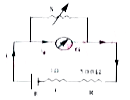What should be the resistance of a galvanometer shunt to give a sensitivity of 1/20 the sensitivity without the shunt? The internal resistance of the galvanometer is 950Ω.
Answer: R = R0/n - 1 = 50 ohms n = 20.Explanation:To decrease the sensitivity of the galvanometer to l/n of its value without the shunt it is necessary to have a shunt current of In — l/n where I is the current in the circuit.
Related Solutions
The sensitivity of a galvanometer is 60 division /A . When a shunt is used, its sensitivity becomes 10 division/A. If the galvanometer is of resistance , the value of shunt used is
View SolutionThe sensitivity of a galvanometer is 60 divisions/Amp. When a shunt is used, its sensitivity becomes 10 divisions/amp. If galvanometer is of resistance , · the value of shunt used is :
View SolutionThe sensitivity of a galvanometer is 60 divisions/Amp. When a shunt is used, its sensitivity becomes 10 divisions/amp. If galvanometer is of resistance , · the value of shunt used is :
View SolutionA galvanometer has a sensitivity of 60 divisions . When a shunt is used, its sensitivity becomes 10 divisions . What is the value of shunt used, if the resistance of galvanometer is 20 ohm.
View SolutionThe sensitivity of a galvanometer that measure current is decreased by times bu using shunt resistance of
Then , the value of the resistance of the galvanometer is
View SolutionA galvanometer has a resistance of 500 ohm. It is shunted so that its sensitivity decreases by 100 times. Find the shunt resistance.
View SolutionA galvanometer has resistance 500 ohm. It is shunted so that its sensitivity decreases by 100 times. Find the shunt resistance.
View SolutionA galvanometer has resistance 500 ohm. It is shunted so that its sensitivity decreases by 100 times. Find the shunt resistance.
View SolutionThe sensitivity of the moving coil galvanometer is s. If the resistance of the galvanometer ((1)/(8))^("वें") A shunt of the part is connected to the moving coil of the galvanometer, then its sensitivity becomes:
View SolutionSensitivity of moving coil galvanometer is s. If a shunt of ((1)/(8))^(th) of the resistance of galvanometer is connected to moving coil galvanometer, its sensitivity becomes
View SolutionSensitivity of moving coil galvanometer is 's'. If a shunt of of the resistance of galvanometer is connected to moving coil galvanometer, its sensitivity becomes
View SolutionThe sensitivity of a galvanometer of resistance 990Omega is increased by 10 times. The shunt used is
View SolutionA galvanometer has a current sensitivity of 1mA per division. A variable shunt is connected across the galvanometer and the combination is put in series with a resistance of 500 and cell of internal resistance 0.5 . It gives a deflection of 5 division for shunt of 5 ohm and 20 division for shunt of 25 ohm. Find the emf of cell and resistance of galvanometer.

View SolutionWhat is the value of the shunt to be connected to a galvanometer with internal resistance R = 10,000 ohm to reduce its sensitivity by n=50 times.
View SolutionThe sensitivity of a galvanometer that measures current is decreased by 1//40 times by using shunt ressitance of 10Omega . Then, value of resistance of the galvanometer is
View SolutionThe sensitivity of a galvanometer is 60 divisions per ampere. When a shunt is used its sensitivity becomes 10 divisions per ampere. If the galvanometer is of 20 Omega resistance, the value of the shunt is :
View SolutionSensitivity of moving coil galanometer is 'S'. If a shunt of th of the resistant of galvanometer is connected to moving coil galvanometer, its sensitivity becomes.
View SolutionSelect and write the corrcet answer : When shunted , the current sensitivity of a galvanometer reduces by a factor of 100. The resistance of the shunt is
View SolutionA galvanometer has a current sensitivity of 1 mA per division. A variable shunt is connected across the galvanometer and the combination is put in series with a resistance of and cell of internal resistance . It gives a deflection of 5 division for shunt of 5 ohm and 20 division for shunt of 25 ohm. The emf of cell is
View Solution